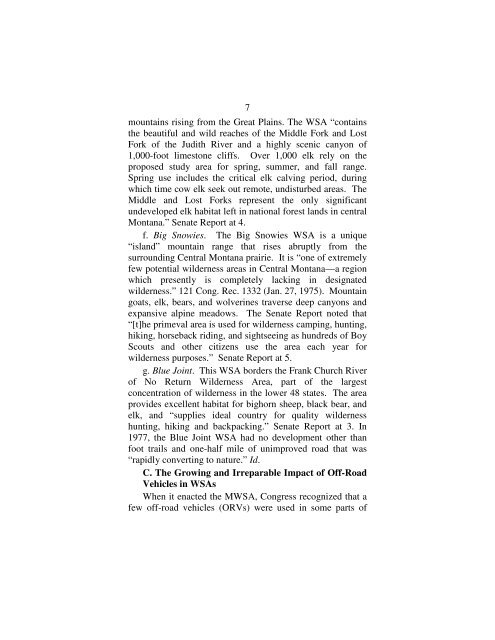Brief Amicus Curiae Of Montana Wilderness Association In Support ...
Brief Amicus Curiae Of Montana Wilderness Association In Support ...
Brief Amicus Curiae Of Montana Wilderness Association In Support ...
Create successful ePaper yourself
Turn your PDF publications into a flip-book with our unique Google optimized e-Paper software.
7<br />
mountains rising from the Great Plains. The WSA “contains<br />
the beautiful and wild reaches of the Middle Fork and Lost<br />
Fork of the Judith River and a highly scenic canyon of<br />
1,000-foot limestone cliffs. Over 1,000 elk rely on the<br />
proposed study area for spring, summer, and fall range.<br />
Spring use includes the critical elk calving period, during<br />
which time cow elk seek out remote, undisturbed areas. The<br />
Middle and Lost Forks represent the only significant<br />
undeveloped elk habitat left in national forest lands in central<br />
<strong>Montana</strong>.” Senate Report at 4.<br />
f. Big Snowies. The Big Snowies WSA is a unique<br />
“island” mountain range that rises abruptly from the<br />
surrounding Central <strong>Montana</strong> prairie. It is “one of extremely<br />
few potential wilderness areas in Central <strong>Montana</strong>—a region<br />
which presently is completely lacking in designated<br />
wilderness.” 121 Cong. Rec. 1332 (Jan. 27, 1975). Mountain<br />
goats, elk, bears, and wolverines traverse deep canyons and<br />
expansive alpine meadows. The Senate Report noted that<br />
“[t]he primeval area is used for wilderness camping, hunting,<br />
hiking, horseback riding, and sightseeing as hundreds of Boy<br />
Scouts and other citizens use the area each year for<br />
wilderness purposes.” Senate Report at 5.<br />
g. Blue Joint. This WSA borders the Frank Church River<br />
of No Return <strong>Wilderness</strong> Area, part of the largest<br />
concentration of wilderness in the lower 48 states. The area<br />
provides excellent habitat for bighorn sheep, black bear, and<br />
elk, and “supplies ideal country for quality wilderness<br />
hunting, hiking and backpacking.” Senate Report at 3. <strong>In</strong><br />
1977, the Blue Joint WSA had no development other than<br />
foot trails and one-half mile of unimproved road that was<br />
“rapidly converting to nature.” Id.<br />
C. The Growing and Irreparable Impact of <strong>Of</strong>f-Road<br />
Vehicles in WSAs<br />
When it enacted the MWSA, Congress recognized that a<br />
few off-road vehicles (ORVs) were used in some parts of
















